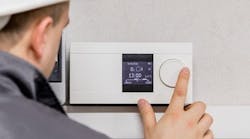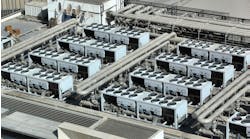One of the buzzwords with all building systems today is controls, especially with HVAC. Heating and cooling equipment is one of the easiest places to reduce energy spend and improve workplace productivity, and comprehensive controls optimize these operations. What do you need to do to get the most out of your HVAC system?
and improve workplace productivity, and comprehensive controls optimize these operations.
1) Consider Your Building Envelope
Although your HVAC system addresses interior comfort, it is important to consider how it will work with the exterior elements of your facility. Identify how you can use your HVAC controls while also considering how the envelope can affect the interior of your building.
Related: 4 C's of HVAC Systems
For example, windows are an important component of thermal comfort in facilities. If you have a lot of daylighting and little to prevent solar heat gain, it might be time to find a solution that can work in unison with your HVAC system. Whether that’s electrochromic windows or automated shading solutions, having them under shared controls can help you optimize energy efficiency by simply mitigating sunlight transmission.
2) Integrate with Other Building Systems
It isn’t enough to run controls with your HVAC system alone; that's a wasted opportunity for wholesale improvements to building efficiency. Buildings today need to operate as one cohesive ecosystem for peak efficiency, and advanced controls are a simple way to link your building systems together.
Lighting is one of the best systems to integrate controls with HVAC because both systems operate largely based on occupancy. Linking lights, HVAC, occupancy sensors and controls together will allow you to essentially multi-task by using one main dataset as a means to control multiple building systems.
While HVAC and lighting are a good starting point for this coordination among building systems, you can be creative and innovate ways to optimize building performance. Working closely with consultants and engineers can open up unique avenues for efficiency through shared controls.
3) Find a Knowledgeable Integrator
The most important part of implementing a strong controls system for HVAC is to enlist the help of someone that has the right expertise. It seems simple, but a lack of education and awareness about the potential for modern controls sets buildings back from reaching their potential in terms of efficiency and comfort.
Even if your contractor or integrator have undergone training to implement these new systems and controls, it is important that they have had opportunities to demonstrate these skills first. Despite the resolute nature of some of these programs, often developed by the manufacturers themselves, some important components of the integration process get lost in translation from the highly controlled training apparatuses to your actual facility.
Trending: Is Your HVAC System Spreading Thirdhand Smoke?
Finding out how the experts you consult with have put their expertise to use is a great way to identify whether they are right for your building. Ask about their past projects and what they can do for yours.
Finally, doing some homework yourself can help you identify what you might want for your building. Taking notes on applications you find and seeing how you might be able to leverage them in your facility will get you closer to the best HVAC practices.
Justin Feit was an Associate Editor for BUILDINGS.
Two hand-picked articles to read next:


